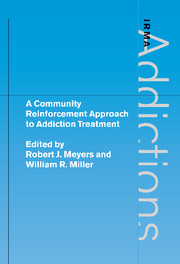Book contents
- Frontmatter
- Contents
- List of contributors
- Preface
- Acknowledgments
- 1 Developing the Community Reinforcement Approach
- 2 Practice and Promise: The Azrin Studies
- 3 The Treatment
- 4 A Comparison of CRA and Traditional Approaches
- 5 Community Reinforcement and Traditional Approaches: Findings of a Controlled Trial
- 6 CRA with the Homeless
- 7 CRA and Treatment of Cocaine and Opioid Dependence
- 8 Community Reinforcement and Family Training (CRAFT)
- 9 Summary and Reflections
- References
- Index
9 - Summary and Reflections
Published online by Cambridge University Press: 05 August 2012
- Frontmatter
- Contents
- List of contributors
- Preface
- Acknowledgments
- 1 Developing the Community Reinforcement Approach
- 2 Practice and Promise: The Azrin Studies
- 3 The Treatment
- 4 A Comparison of CRA and Traditional Approaches
- 5 Community Reinforcement and Traditional Approaches: Findings of a Controlled Trial
- 6 CRA with the Homeless
- 7 CRA and Treatment of Cocaine and Opioid Dependence
- 8 Community Reinforcement and Family Training (CRAFT)
- 9 Summary and Reflections
- References
- Index
Summary
The chapters of this book have told the story of the Community Reinforcement Approach (CRA) from its very beginning in the late 1960s through current research at the start of a new century. The studies described here have involved nearly a thousand clients treated with CRA for alcohol and illicit drug problems. Most of these clients have had relatively severe substance dependence, and many (as exemplified in the study with homeless adults in Chapter 6) have had many other serious life problems and diagnoses as well. There is no sense in which any of these were particularly “good prognosis” populations.
But then prognosis, like motivation, is not merely a matter of client characteristics. Prognosis occurs in the context of available treatments. Many diseases that at one time were typically terminal are now readily treatable. Similarly, there are now effective and even brief treatments for psychological problems that just a few decades ago were thought to be relatively intractable. Prognosis also has to do with the availability of effective treatment methods. It was the promise of effectiveness that drew us to CRA. The Azrin studies, outlined in Chapter 2, provided some of the strongest empirical evidence for the efficacy of any treatment method for alcohol dependence. Yet in spite of promising evidence, CRA was rarely used, and most practitioners had never even heard of it. We wanted to see whether CRA would work in our hands, in a very different culture from rural Illinois where it was born, and with some of the “toughest” clients we could find, in a real-life treatment agency.
Our collaboration is now entering its third decade, and we know much more than when we began.
Keywords
- Type
- Chapter
- Information
- A Community Reinforcement Approach to Addiction Treatment , pp. 161 - 170Publisher: Cambridge University PressPrint publication year: 2001
- 1
- Cited by



